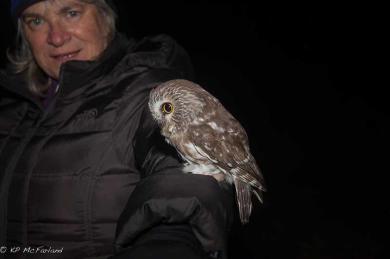
Birdwatcher Carol Suich had never seen a Northern Saw-whet owl. This was a life bird for her that perched on her arm after it was banded before taking off into the night.
One of the most common owls in forests across northern North America during the breeding season, Northern Saw-whet Owls are nocturnal and seldom seen. But you may hear them. Listen for a sharp, high, repeated too-too-too call, reminiscent of the sound a truck makes to warn you it is backing up.
During October and November they migrate southward from their northern haunts to spend the winter in dense forests across the central and southern US. Hundreds of biologists are studying their migration and populations across the continent at banding stations, several of them in Vermont.
This month on Outdoor Radio, VCE biologists Kent McFarland and Sara Zahendra join North Branch Nature Center to witness the process of capturing and banding an owl, and a local bird watcher experiences the thrill of seeing a Northern Saw-whet Owl for the first time.
Learn more:
- You can see where the Northern Saw-whet owl has been tracked across the country on a dynamic live range map at Vermont eBird, a project of the Vermont Atlas of Life. And, you can add your sightings too.
- View the annual phenology of Northern Saw-whet Owl sightings in Vermont at Vermont eBird.
- Project Owlnet coordinates biologists across the country in saw-whet owl banding efforts.
- The Cornell Lab of Ornithology offers this summary of Northern Saw-whet Owl behavior and habitat.
- Learn more about North Branch Nature Center in Montpelier, and their bird banding.
Outdoor Radio is a monthly feature produced in collaboration with Vermont Public Radio. The program is made possible by the VPR Journalism Fund and by a grant to VCE from the Vermont Community Foundation. The program is produced and edited by VPR’s Chief Production Engineer, Chris Albertine.

I really enjoyed the piece on saw-whet owls. It brought back the time I was privileged to hold and release one.